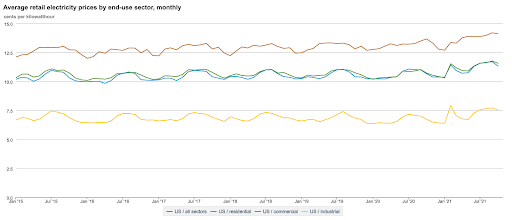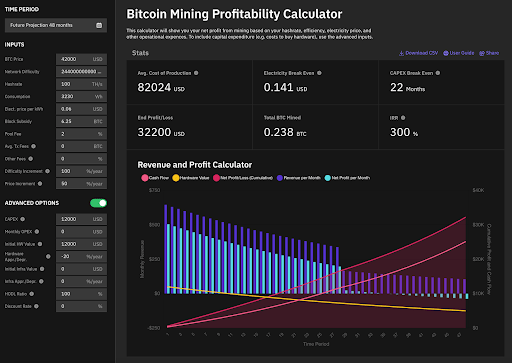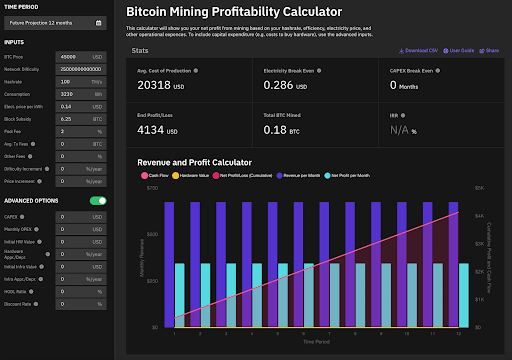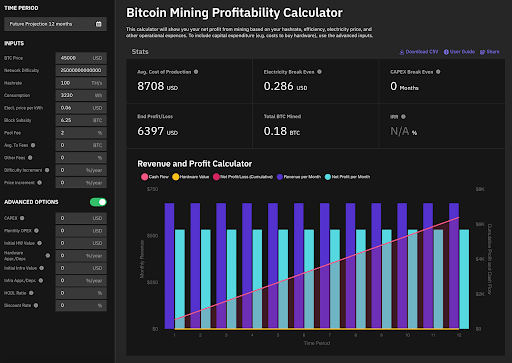
Is the Antminer S19 XP Worth It? Part 2
Is the Antminer S19 XP Worth It? (ASIC Value Analysis) Part 2 Part 1 Recap To briefly recap on Part 1, we compared the mining profitability of two Antminer...
If you’ve come across this article, you probably have an interest in investing in BTC in some capacity. While participation in the Bitcoin industry can take on many forms, regular investors typically gain exposure in one (or both) of two ways. That is, outright buying Bitcoin (spot investment), or building out a Bitcoin mining operation to start mining. Of course, these two options are not mutually exclusive, and there are several approaches to either route.
However, because there are so many interesting variables that play into Bitcoin mining, there is no one correct way to invest in bitcoin mining that will be appropriate for everyone. In this article we’re going to explore some Bitcoin mining basics so you can decide if it’s a good opportunity for you.
Considering every cost that is associated with mining, perhaps the most important is the cost of electricity. While capital expenditures like purchasing mining hardware and building infrastructure can be sizable upfront, energy costs become more significant when added up over time.
Because the cost of electricity is the most important operational expense associated with Bitcoin mining, miners must seek out the lowest electricity prices they can to be competitive and profitable. At the time of this article, the price of electricity that small and medium sized miners generally pay is around 5-7 cents/kWh.
While many miners run their mining rigs with even cheaper electricity, the trade-off they take to get there usually requires higher capital expenditures in infrastructure. Building out a Bitcoin mining operation that allows for low electricity prices often comes at the cost of building or acquiring an energy asset (wind or solar farm, for example). When you factor these additional infrastructure costs in, the bills usually end up in a similar range to using 5-7 cents/kWh.Mining at home is an entirely different story, however. While it is of course possible to purchase an Antminer S19, set it up, and start mining at home, competing with industrial miners would be difficult in most circumstances. Residential electricity prices are much higher than the competitive target of 5-7 cents/kWh. According to the EIA (US Energy Information Administration) the average residential electricity price in the US is 14.11 cents/kWh.

Yet, despite the higher electricity prices, the home miner still has options that could drastically help them mine. An excellent option for anyone seriously interested in Bitcoin mining, from home mining to large scale operations, is to find a bitcoin miner hosting provider, such as our Managed Mining Program. With Managed Mining, we mine using environmentally conscious electricity (surplus wind power + traditional grid power) priced at 4.2 cents/kWh so our clients can enjoy the highest profits possible.
Not only do we house your mining rig in our highly advanced mining POD infrastructure, we also monitor and manage it 24/7. Since we are responsible for your machines, we provide free replacement parts should anything go awry with your mining hardware. Our goal is to create a frictionless mining solution accessible to all while maximizing your profits.
To make Bitcoin mining as worthwhile as possible, most miners set out with the goal to break even on capital investments as soon as possible.
However, projecting the profitability of a Bitcoin mining rig is a bit more complicated than simply accounting for upfront and overhead costs. Two major influences on mining profitability are the price of BTC and network difficulty. For differing reasons, both factors are susceptible to fluctuations. Fortunately, we have tools at our disposal that can help us project profitability during growth and decline periods.
To further understand the effect BTC price and difficulty can have, let’s look at some basic capital expenditure break-even simulations. We’ll use a Mining Profitability Calculator to estimate when you would break even on an investment given different scenarios.
For each calculation, our analyzed mining rig will be an Antminer S19 100Th that we’ll run for 4 years, with a stable electricity price of 6 cents/kWh. Our starting difficulty will be 24.4T, and our starting price will be set to $42K. Also our CapEx will be $12,000 (price of the Antminer S19), but will depreciate at 20%/year. And our HODL ratio will sit at 100%.
*[The Antminer S19 100Th has a maximum hash rate of 100 Th/s, power consumption of 3230W±10%, and power efficiency of 32.5 W/Th]
Bearish S5cenario: Difficulty increases 100%/year, and BTC only increases 50%/year

Another key component Bitcoin miners must be aware of is Bitcoin’s price. It’s likely true that if you are a miner, you’re going to be bullish on BTC price, and expect “Number go up!” over time. While Bitcoin’s historical numbers show a compounded average growth rate of 197% per year, the price can be unpredictable, especially in the short term.
BTC price can be volatile with large swings in either direction at any point. That’s why it’s good practice to first be conservative and model your mining business as if BTC price will not increase over time while difficulty does. Modeling like this helps you decide if you would be comfortable during a “bearish” scenario.
Other useful perspectives to consider can be found when analyzing events where price and difficulty increase roughly proportionately, or when price increases faster than difficulty does. How do these scenarios affect your outlook on mining in the long term? In our article Why Bitcoin ASIC Prices Can Reach New Highs In 2022, we took a deep look at why difficulty and BTC price not only affects profitability but also ASIC (mining hardware) pricing.
For a more straightforward approach, a great tool is the Bitcoin Mining Profitability Calculator from Braiins. With this calculator, you’re able to adjust the difficulty, BTC price, ASIC pricing, electricity prices and more to predict profitability over time. Which brings us to the next factor in Bitcoin mining.
One of the top priorities new miners have is to find and utilize a cheap source of energy. This is because Bitcoin mining machines tend to soak up lots and lots of power, making energy costs the majority of a miner’s operational expenses. To minimize energy expenses, miners try to find the cheapest energy source possible to allow them to be more competitive in the long-term.
The average cost of electricity (residential) in the United States is $0.14/kWh. The cost per kWh most miners feel competitive at is about $0.06/kWh or less. Of course, mining can still work at higher electricity prices, but a greater energy cost means more risk. Our Managed Mining services operate at roughly $0.042/kWh, thanks to our green and renewable energy sources.
But to better understand the impact of energy costs, let’s take an example. One of the best selling mining machines, the Antminer S19, has a maximum hashrate of 100 Th/s, power consumption of 3230W±10%, and power efficiency of 32.5 W/Th. Using the Profitability Calculator mentioned above, we’ll calculate the differences in operating expenses for one year for residential and industry standard electricity prices. For simplicity’s sake, we’ll calculate using a constant network difficulty of 25T, and BTC price of $45K.
Electricity Price : $0.14/kWh

Electricity Price : $0.06/kWh

Clearly, the price of electricity has a massive effect on the risk a miner takes on, even when running just one machine! Despite the unrealistically frozen difficulty and BTC price inputs, the average cost of production for 1 BTC is reduced by $12k, leading to over $2k higher-end profit for the operation with $0.06/kWh electricity.
The other common source of OpEx for mining operations is labor. However, on a per-machine basis, labor is likely an insignificant expense compared to electricity costs.
When it comes to upfront costs, a good chunk of expenditures should be reserved for the infrastructure required to house your Bitcoin mining rig. Mining facilities must be robust enough to protect your mining machines, and also need to be capable of meeting the demands of ASICs.
Modern bitcoin mining machines such as Antminer S19’s, WhatsMiner M30S’s, and Avalon 1246’s, all consume upwards of 3000W per unit. As a result, they have extremely high heat output and need to be cooled constantly to maintain optimized performance. Aside from the demanding air flow requirements, the electrical engineering needed to deliver large amounts of power reliably to all of your machines can be complicated. The good news is once you’ve sufficiently constructed your facility to meet your ASIC’s demands, the output from your mining machines should reward you.
Another bonus of investing in proper infrastructure is it retains long-term value and can (hopefully) be used for many generations of Bitcoin machines.
Although infrastructure costs shouldn’t be dismissed, the purchasing of mining hardware is where most of a miner’s risk is placed. Miners generally take 1-2 years to break-even after purchasing ASIC hardware. But being bullish about BTC price over time is what drives investment in mining. If BTC price goes up faster than difficulty, it’s much easier for a miner to be profitable.
These mining machines do well at retaining their value or even appreciate significantly in short time periods. The key is creating sufficient infrastructure to keep these machines running efficiently and optimally.But which mining machine will be best suited for your mining operation? We’ve created a few guides to shed some light on Bitmain’s Antminer S19 series, and have also discussed other popular options like the newest-generation Antminer S19 XP, the Antminer S19J, and several others. Our Learn section also has several other articles that can help you decide how you’d like to mine!
While it is entirely possible to invest in Bitcoin mining, running a physical operation yourself is an entirely separate endeavor. Between the physical components of Bitcoin mining (purchasing and maintaining ASICs mining machines, obtaining an inexpensive and reliable energy source, and constructing and maintaining the infrastructure) and the psychological requirements needed to monitor BTC price and mining difficulty, mining is definitely a full-time job if done at scale. But the rewards for sticking around can easily be just as sweet.
For those who want exposure to this lucrative industry without all the hassles of building out infrastructure and maintaining a whole mining operation, our Managed Mining program is for you. With Managed Mining, we work for you to take all the stress and hassles out of the equation. We mine with clean, low-cost energys, constant machine monitoring, and we utilize in-house infrastructure to host your machines. All you need to do after you invest is sit back and reap the returns.For more information on Managed Mining, visit our site or speak with a representative.
Is the Antminer S19 XP Worth It? (ASIC Value Analysis) Part 2 Part 1 Recap To briefly recap on Part 1, we compared the mining profitability of two Antminer...
By Adan Kohnhorst Oslo Freedom Forum Bitcoin Panels Headlines in major publications are quick to decry Bitcoin over the industry’s perceived environmental impact. But are these concerns well-founded, or...
By Spencer Sherwood If you’ve come across this article, you probably have an interest in investing in BTC in some capacity. While participation in the Bitcoin industry can take...
By Spencer Sherwood Ever since Bitcoin mining was banned in China during 2021, investors have been taking advantage of the opportunity and pouring money into mining operations elsewhere in...
By Spencer Sherwood We recently came across an article written in March 2022 by economist Severin Borenstein in the Energy Institute at Hass which made the case that crypto...
By Daniel Frumpkin The bitcoin mining industry had a year to remember in 2021, with exponential growth in the Western market led by publicly traded mining companies in Canada...